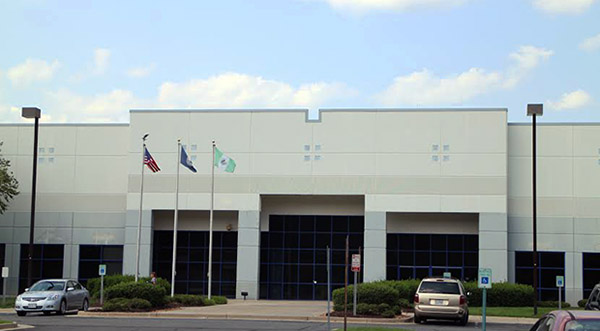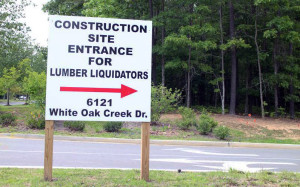
White Oak Distribution Center’s 200 building is one of the complex’s filled spaces. White Oak has a total of about 88,000 square feet of vacant space. Photos by Burl Rolett.
It’s a good time to own a warehouse in Richmond – at least one with 24-foot ceilings.
A recent run of large industrial leases in the area has pushed vacancy rates for newer high-ceiling and well-located warehouses from 2009’s double-digit highs down to about 4.5 percent, according to the latest reports from local real estate brokerages.
Second quarter deals alone filled more than 620,000 square feet of vacant top-tier space, according to a CBRE | Richmond metric that tracks performance of the market’s top-of-the-line industrial space.
The trend has prompted at least one developer to dive into speculative warehouse building and has brokers wondering if more space is on the way in the coming years.
“Historically there just hasn’t been a lot of spec development in Richmond. We’re kind of a secondary or tertiary market for a lot of big developers,” JLL industrial broker Scott Keeton said. “If ever the time was right, it’s probably now.”
CBRE | Richmond research shows that there is only about 1 million square feet of available top-tier industrial space available in the area market. That number drops to about 350,000 square feet for top-end buildings with at least 24-foot ceilings, a sought-after amenity for certain tenants.
Some of the recent momentum was fueled by two big leases signed by American Signature in April, each at about 220,000 square feet on Carolina Avenue near Richmond International Raceway and on Washington Highway in Hanover County. Also in April, Mosaic Tile leased another 215,000-square-foot space in Hanover.
On the East End in recent months, 280,000 square feet at White Oak Distribution Center vacated by Hewlett-Packard was snatched up by two tenants before HP had moved out. New-to-Richmond company Syncreon USA took 120,000 square feet at the White Oak center, and Premier Fixtures consolidated two locations to fill another 160,000 square feet at the park. Commercial real estate firm JLL worked both those deals.
The Syncreon and Premier Fixtures leases leave only about 88,000 square feet worth of space at White Oak Distribution Center.
Other still-empty warehouses include blocks of space at Interport Business Center and a 100,000-square-foot-plus vacancy at River’s Bend in Chesterfield County.
But that’s about it for companies in the market for a large block of quality industrial space.
“In terms of class-A space, it’s a pretty short list,” said Keeton, who represented the landlord in the White Oak Distribution Center deals.
That’s not to say the pace of industrial development has slowed in the Richmond area. There is about 3 million square feet of new industrial space either under construction or in planning around the region.
Most of that, however, will be build-to-suit properties that are leased out and constructed based on a predetermined tenant’s need.
Phillip Morris will build 1 million square feet between four warehouses in Chesterfield, and another 400,000 square feet is being built for Medline at Meadowville Techology Park. Lumber Liquidators is adding 1 million square feet at Henrico County’s White Oak Tech Park, and National Republic is working on a 260,000-square-foot distribution center in Hanover.
That’s in addition to the 311,000-square-foot Vitamin Shoppe distribution center that opened last year and the 1 million-square-foot Amazon fulfillment center that started the trend in 2011.
Those deals have helped boost the Richmond distribution center market, and brokers say the attention may have made other, smaller companies think of Richmond. But brokers also generally agree the market could use some new speculative industrial space.
Liberty Property Trust will test that idea with a 130,000-sqare-foot space at Eastport Industrial Park set to be finished in November.
The Liberty industrial space will break Richmond region’s five-year streak without any speculative construction.
Chip Louthan, a broker with Colliers International, said a lack of new space can shut entire industries out of Richmond.
“When you go five years without new space, there are probably a lack of buildings to handle FDA-approved products, especially food,” Louthan said. “You can’t handle that kind of stuff in older buildings normally.”
A low market vacancy isn’t the only ingredient needed to get shovels in the ground for spec development.
New construction is expensive, and developers need to be able to make their investment back through higher rental rates. Liberty, for example, is putting $8 million into its Eastport VIII project.
The asking rate for the building was at $5.25 per square foot in June, about a dollar more expensive than the average rate for similar buildings across the Richmond market.
Speculative construction may gain momentum as prices rise. Rob Dirom, a CBRE | Richmond industrial broker, said rents may begin to trend up, but it won’t happen immediately. He added that a flood of new space hit the market between 10 and 15 years ago, and demand is just now beginning to catch up with that inventory.
The recent trends are giving industrial landlords a position of leverage in lease negotiations. As supply dwindles, property owners will look to pull back on concessions they once offered to tenants, Dirom said.
For example, a landlord may require a longer lease commitment or stop offering free rent incentives. A Cushman and Wakefield | Thalhimer industry report says many incentives offered in recent years are already gone.
These trends aren’t exclusive to Richmond.
“Every other market in the southeast that is about the size of Richmond is experiencing the exact same thing,” Dirom said. “We’re now in competition for developers with all of these other middle-tier cities – what they can offer, how fast their absorption curve is growing and where their rents are.”
Meanwhile, Keeton said, the industry is keeping close tabs on Liberty’s 130,000 square feet of spec space that is on the rise.
“All eyes are on what Liberty is doing, frankly, and I know they’ve had tremendous activity out there,” he said of the company’s Eastport property. “But the market is waiting to see that that gets leased up, and hopefully it will be a bellwether for some new development.”

White Oak Distribution Center’s 200 building is one of the complex’s filled spaces. White Oak has a total of about 88,000 square feet of vacant space. Photos by Burl Rolett.
It’s a good time to own a warehouse in Richmond – at least one with 24-foot ceilings.
A recent run of large industrial leases in the area has pushed vacancy rates for newer high-ceiling and well-located warehouses from 2009’s double-digit highs down to about 4.5 percent, according to the latest reports from local real estate brokerages.
Second quarter deals alone filled more than 620,000 square feet of vacant top-tier space, according to a CBRE | Richmond metric that tracks performance of the market’s top-of-the-line industrial space.
The trend has prompted at least one developer to dive into speculative warehouse building and has brokers wondering if more space is on the way in the coming years.
“Historically there just hasn’t been a lot of spec development in Richmond. We’re kind of a secondary or tertiary market for a lot of big developers,” JLL industrial broker Scott Keeton said. “If ever the time was right, it’s probably now.”
CBRE | Richmond research shows that there is only about 1 million square feet of available top-tier industrial space available in the area market. That number drops to about 350,000 square feet for top-end buildings with at least 24-foot ceilings, a sought-after amenity for certain tenants.
Some of the recent momentum was fueled by two big leases signed by American Signature in April, each at about 220,000 square feet on Carolina Avenue near Richmond International Raceway and on Washington Highway in Hanover County. Also in April, Mosaic Tile leased another 215,000-square-foot space in Hanover.
On the East End in recent months, 280,000 square feet at White Oak Distribution Center vacated by Hewlett-Packard was snatched up by two tenants before HP had moved out. New-to-Richmond company Syncreon USA took 120,000 square feet at the White Oak center, and Premier Fixtures consolidated two locations to fill another 160,000 square feet at the park. Commercial real estate firm JLL worked both those deals.
The Syncreon and Premier Fixtures leases leave only about 88,000 square feet worth of space at White Oak Distribution Center.
Other still-empty warehouses include blocks of space at Interport Business Center and a 100,000-square-foot-plus vacancy at River’s Bend in Chesterfield County.
But that’s about it for companies in the market for a large block of quality industrial space.
“In terms of class-A space, it’s a pretty short list,” said Keeton, who represented the landlord in the White Oak Distribution Center deals.
That’s not to say the pace of industrial development has slowed in the Richmond area. There is about 3 million square feet of new industrial space either under construction or in planning around the region.
Most of that, however, will be build-to-suit properties that are leased out and constructed based on a predetermined tenant’s need.
Phillip Morris will build 1 million square feet between four warehouses in Chesterfield, and another 400,000 square feet is being built for Medline at Meadowville Techology Park. Lumber Liquidators is adding 1 million square feet at Henrico County’s White Oak Tech Park, and National Republic is working on a 260,000-square-foot distribution center in Hanover.
That’s in addition to the 311,000-square-foot Vitamin Shoppe distribution center that opened last year and the 1 million-square-foot Amazon fulfillment center that started the trend in 2011.
Those deals have helped boost the Richmond distribution center market, and brokers say the attention may have made other, smaller companies think of Richmond. But brokers also generally agree the market could use some new speculative industrial space.
Liberty Property Trust will test that idea with a 130,000-sqare-foot space at Eastport Industrial Park set to be finished in November.
The Liberty industrial space will break Richmond region’s five-year streak without any speculative construction.
Chip Louthan, a broker with Colliers International, said a lack of new space can shut entire industries out of Richmond.
“When you go five years without new space, there are probably a lack of buildings to handle FDA-approved products, especially food,” Louthan said. “You can’t handle that kind of stuff in older buildings normally.”
A low market vacancy isn’t the only ingredient needed to get shovels in the ground for spec development.
New construction is expensive, and developers need to be able to make their investment back through higher rental rates. Liberty, for example, is putting $8 million into its Eastport VIII project.
The asking rate for the building was at $5.25 per square foot in June, about a dollar more expensive than the average rate for similar buildings across the Richmond market.
Speculative construction may gain momentum as prices rise. Rob Dirom, a CBRE | Richmond industrial broker, said rents may begin to trend up, but it won’t happen immediately. He added that a flood of new space hit the market between 10 and 15 years ago, and demand is just now beginning to catch up with that inventory.
The recent trends are giving industrial landlords a position of leverage in lease negotiations. As supply dwindles, property owners will look to pull back on concessions they once offered to tenants, Dirom said.
For example, a landlord may require a longer lease commitment or stop offering free rent incentives. A Cushman and Wakefield | Thalhimer industry report says many incentives offered in recent years are already gone.
These trends aren’t exclusive to Richmond.
“Every other market in the southeast that is about the size of Richmond is experiencing the exact same thing,” Dirom said. “We’re now in competition for developers with all of these other middle-tier cities – what they can offer, how fast their absorption curve is growing and where their rents are.”
Meanwhile, Keeton said, the industry is keeping close tabs on Liberty’s 130,000 square feet of spec space that is on the rise.
“All eyes are on what Liberty is doing, frankly, and I know they’ve had tremendous activity out there,” he said of the company’s Eastport property. “But the market is waiting to see that that gets leased up, and hopefully it will be a bellwether for some new development.”

